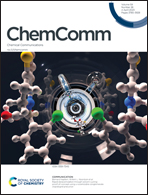An electrochemical biosensor to identify the phenotype of aggressive breast cancer cells†
Abstract
Identifying the phenotype of aggressive breast cancer (BC) cells is vital for the effectiveness of surgical intervention and standard-of-care therapy. HER-2 is overexpressed in aggressive BC and MMP-2 is a crucial indicator of invasiveness and metastasis of BC, so we have proposed an electrochemical biosensor in this work to identify the phenotype of aggressive BC cells via detection of HER-2 together with MMP-2 by designing a dual-trapping peptide and a metal organic framework (MOF)-based probe. Specifically, the designed peptide contains both a HER-2 recognition sequence and MMP-2-specific substrate, while the MOF-based probe (AuNPs@HRP@ZIF-8), prepared by loading horseradish peroxidase (HRP) and gold nanoparticles (AuNPs) on ZIF-8, can also combine with the peptide. Consequently, sensitive and specific detection of both HER-2 and MMP-2 can be achieved in the wide range from 50 fg mL−1 to 50 ng mL−1 and 10 fg mL−1 to 10 ng mL−1, respectively, and the biosensor can distinguish HER-2+ BC cells and evaluate the invasion capability, which might be extended to provide a method for the accurate identification of tumor features in BC subtypes.



 Please wait while we load your content...
Please wait while we load your content...